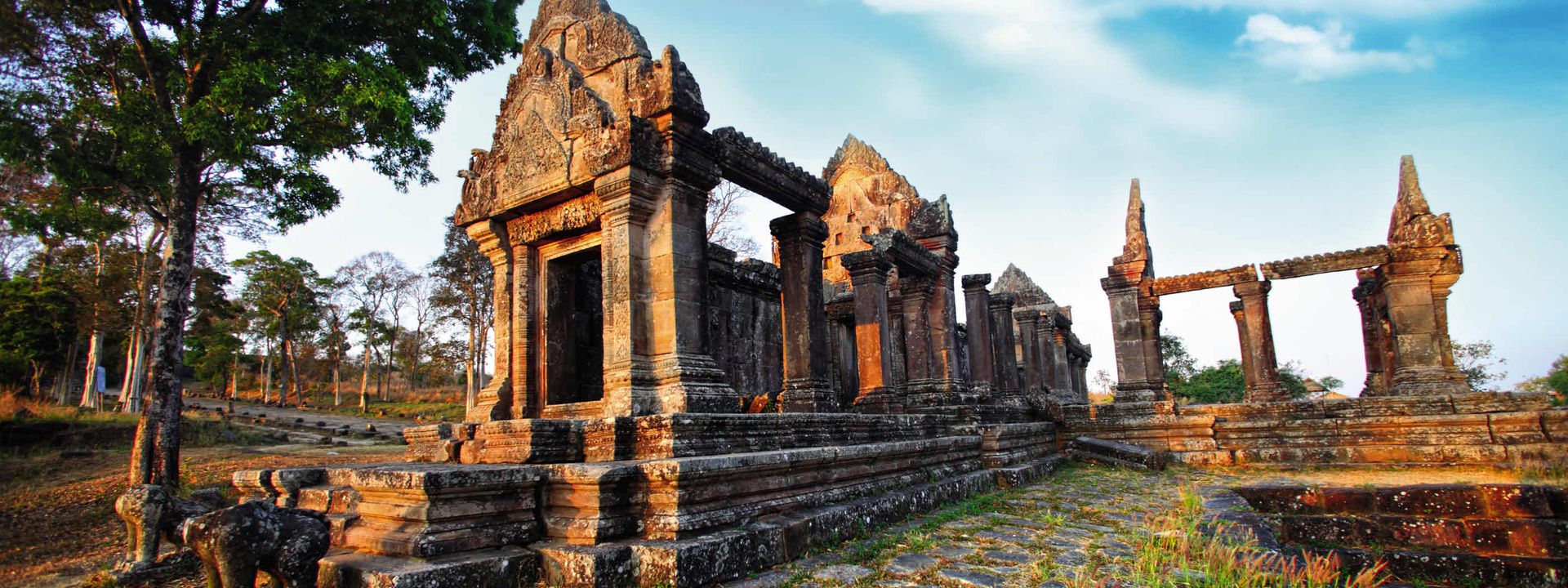
Words : Mark Stratton | 08 October
Wanderlust
In Cambodia's far north lies a temple that drove two nations to war. But now, visitors seeking to flee the crowds of Angkor can find sanctuary in its ruins...
All was not what it seemed in the bamboo and mahogany forests of Cambodia's Dangrek Mountains. Besides cicadas revving like tiny chainsaws, I heard the distant grunts of soldiers performing PT (physical training). A mess tent surrounded by black sandbags rattled to the sound of cooking pans, and fixed to the anaemic bark of a dipterocarpus tree was a red sign bearing a skull and crossbones. Landmines, it warned.
"The mines are cleared now," reassured my guide, Kao Bunthoeun. "But we should stick to the pathway."
We followed the 2,400 steps of the ancient Angkorian Khmer route until reaching a sinuous trench resembling something out of the First World War. It stretched along an escarpment protecting pokey little bunkers and bulwarked by yet more sandbags. There were no Cambodian troops around, so I peeked through a mounted military scope. Less than 250 metres away, I spied a fluttering Thai flag and some camouflaged military tents, before recoiling with surprise at the sight of a pagoda-shaped watchtower manned with soldiers staring right back at me.
Higher still, the early morning sunshine toasted the vast sandstone blocks of a mountaintop temple that remains one of Cambodia's least-known yet most divine expressions of its imperious Angkor dynasty: Wat Preah Vihear, the temple that brought two nations to war.
Like most visitors to Cambodia, I knew little of its existence. Instead, I had arrived days earlier in the modern goldmine of Siem Reap, a congested city of hotels, restaurants and bars that now services the millions of tourists who visit the world-famous Angkor complex each year. I love exploring this ancient wonder, but with every visit the crowds and congestion appear ever greater. I wanted to be dazzled by Angkorian architecture yet free of the endless coach parties.
"Preah Vihear temple gets a handful of visitors each year," promised Richard Saward, a local tour operator I met in Siem Reap. "It's a chance to see authentic Cambodia and spread the benefits of tourism to a poor area."
I was sold, so together with Bunthoeun, a dapper 36-year-old guide with a pencilthin moustache, and our driver, Prom, we set off for Cambodia's far northern borderlands. I was curious about a region still recovering from memories of the notorious Khmer Rouge regime - which held out here a lot longer than anywhere else - and where homestays and littleseen relics of its Angkorian past were helping to change lives far removed from Siem Reap's hectic crowds. But most of all, I wanted to see the temple that divided Cambodia and Thailand for more than a century.
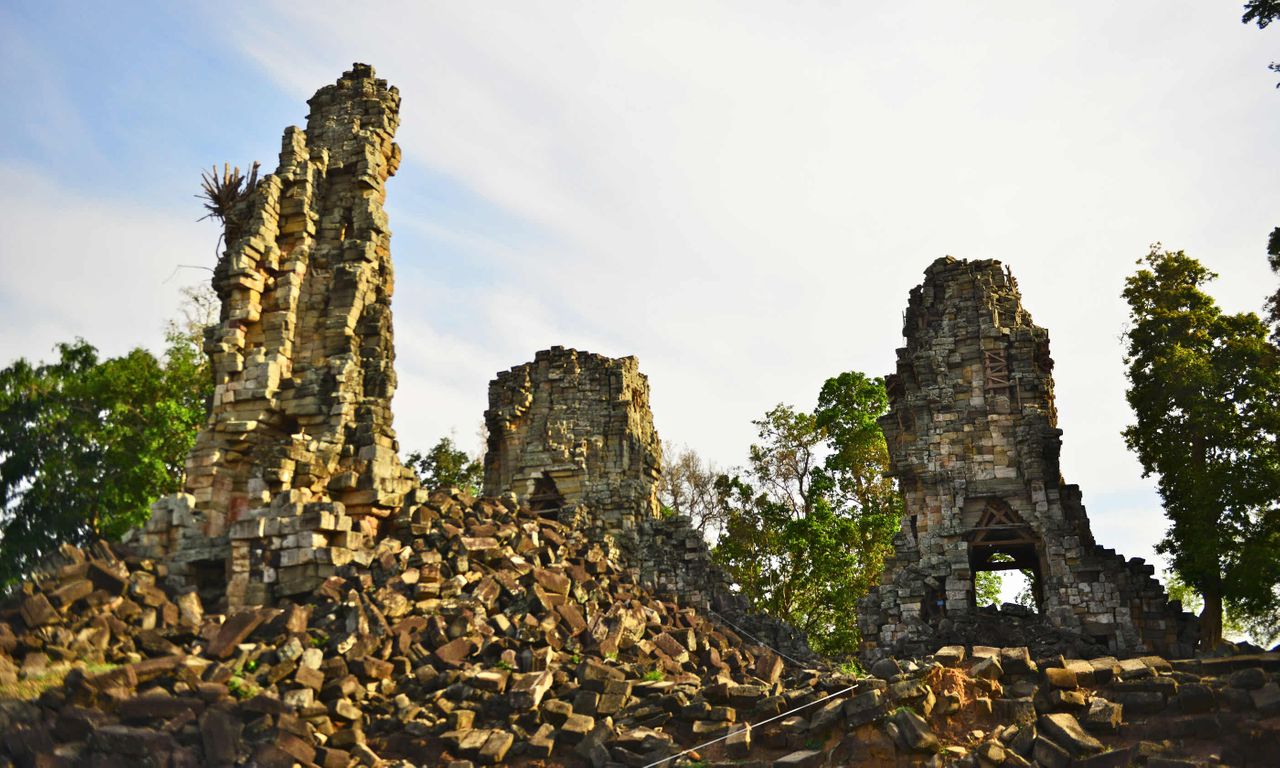
Banteay Top Satellite Temple (Mark Stratton)
War(s) and peace
My fascination with Cambodia lies in its seemingly irreconcilable past. This is a country that has a rich ancient culture yet also a boundless capacity for self-destruction. It was only around 1999, after the murderous Khmer Rouge finally disbanded, that tourists began flocking to Angkor Wat. Yet all the while another dispute simmered away unnoticed along Cambodia's far northern border with Thailand.
The origins of this trouble began with the fall of the Angkor dynasty (around 1432 AD), when Thailand (then Siam) controlled vast swathes of northern Cambodia. In 1907, a treaty between the then French colony and Thailand established that the disputed Preah Vihear temple fell on Cambodian soil, but relations have been strained ever since.
With the fall of the Khmer Rouge, border tensions between the two neighbours renewed. All that was needed to push them over the edge was a spark, which arrived in July 2008 when UNESCO accepted Cambodia's registration of Preah Vihear temple as a World Heritage Site. Fighting erupted, and lasted three years.
It wasn't until 2013, after the International Court of Justice backed Cambodia, that things finally died down. Yet the British Foreign Office only lifted its travel warning in late 2015, and most foreign travellers are still to discover this area despite the relative ease of getting there.
Northern exposure
A newly built road meant that it now only took three-to-four hours to reach Preah Vihear from Siem Reap, instead of the best part of the day. But we decided to take things slowly anyway, enjoying a wealth of cultural and political intrigue en route.
Northern Cambodia delivered a trance-inducing agricultural flatness that reminded me, geographically, of the American Midwest. The rice fields were fallow, so locals had turned their attention to spreading cassava out to dry in the intense sun. Road traffic consisted mainly of rotary cultivators that resembled oversized lawnmowers and had assumed the ploughing duties of the buffalo, though these redundant beasts of burden still lolled in lotus-choked ponds. And in the distance, Thnot palms rose like giant lollipops across the spirit-level flatlands.
After lunch, a visit to Banteay Chhmar fed my desire for crowd-free Angkorian riches. This 12 sq km Khmer outpost is a 12th-century creation the size of Siem Reap's Angkor complex yet receives only a fraction of its rival's visitor numbers every year. When I signed in at 2pm, I was the first foreigner to arrive that day.
A definite sense of imagination is required here, though. The dilapidated complex is enclosed by a baray (reservoir), its bridges lined with ancient stone gods wrestling seven-headed nagas (snakes). The site was built by serial constructor Jayavarman VII (1181-1218), the king responsible for two of Angkor's prime selfie spots: the famous elephant terrace and the stone faces of Bayon. But little has been done to restore it, even after the security issues caused by the Khmer Rouge across the region dissipated.
Still, I felt like a wide-eyed archaeologist scrambling about fallen prasat (towers) and collapsed cloister-like galleries reduced to heaps of honey-coloured masonry and strangled by octopussian tree roots. Amid this elegant chaos we sought out exquisite icons vividly depicting Angkorian life without words. I spent time tracing a self-aggrandising bas-relief over 200 metres long, sensing every blow delivered in the epic river battle it depicted as Jayavarman's armies overcame the invading Cham (Vietnamese), their fallen warriors sna ffed by waiting crocodiles.
Elsewhere, to mark the Angkor Empire's apostasy - when it switched from Hinduism to Buddhism - another divine bas-relief featured a Bodhisattva whose 32 arms optically coalesced like butterfly wings. This ancient world was rendered as clear as any comic book.
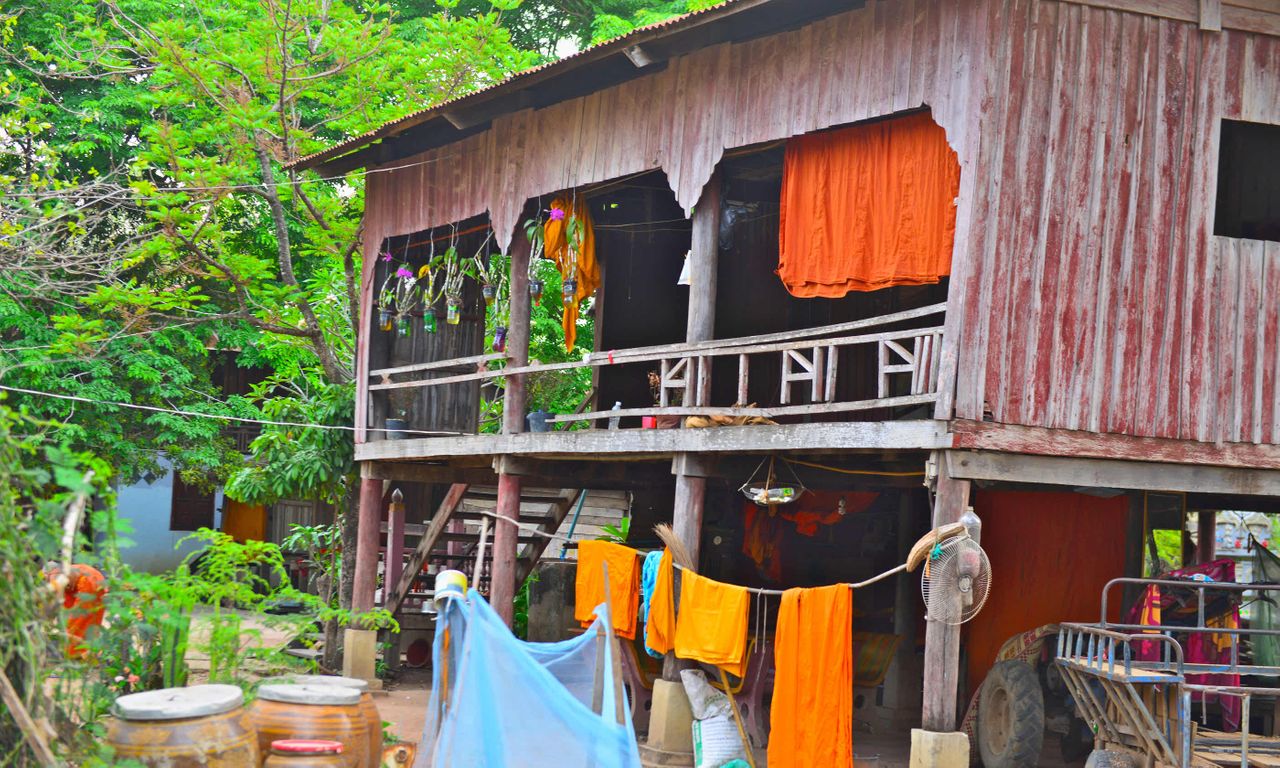
Mrs Nary's village (Mark Stratton)
Starting over
Beyond the moat lay the best evidence of how disseminating tourism away from Siem Reap could benefit Cambodia's local people. Community Based Tourism (CBT) is a cooperative of villages offering homestays and rural activities. I had experienced such schemes before, and while some can feel voyeuristic, this one was welcoming and relaxed, and at their community centre I was soon being shown how to pulp a spicy paste using a mortar and pestle.
Local CBT organiser, Mao Sy, explained most of the beneficiaries were farmers earning just $80 (£63) per month: "They can make $100 to $150 (£80-120) extra monthly with the project," he said. "Tourism has brought us jobs and the money goes directly to the families."
In my case, this meant Mrs Ouch Nary. I lodged in her two-storied wooden house, a huge pomegranate tree stood outside. The room was small but the veranda overlooked a lively procession of exotic tra ffic: mobile truck-shops precariously overloaded with kitchenware, herds of white brahman cattle, barefoot monks bearing alms bowls.
The widowed Mrs Nary had used her homestay money to put her children through education. It was a far cry from her own youth, I learned, when she was a teen bride of the Khmer Rouge, married in a mass wedding ceremony. Life has changed a lot here in a short time.
The legacy of that notorious regime runs deep across the region, however, and driving north later that day, we soon entered Anlong Veng, a district once controlled by the regime.
"In 1979, this area was thick forest and full of guerrillas and landmines. It was very dangerous," explained Bunthoeun.
Between 1975 and '79, the Marxist Khmer Rouge attempted to create a utopian agrarian society called Kampuchea. Around 2 million or so perished under their reign, and for the survivors, life was extremely hard. The regime was finally ousted by the Vietnamese Army in 1979, but it clung on in this region for nearly two more decades. We stopped briefly at the former villa of one of its most important cadres, Ta Mok (aka Brother Number Five). What we found was an austere tiled villa bearing a surprising mural inside, depicting the Preah Vihear temple.
"Ta Mok was once a monk, and loved temples," Bunthoeun said of the man whose nom de guerre was 'The Butcher'. He died in 2006 in captivity without ever facing trial. This might seem like 'dark tourism', but seeing his home somehow made his organisation's malevolent influence seem very real, and only increased my respect for how fast Cambodia - especially the north - had recovered since this macabre regime took the country back to Year Zero. Not least when I stood nearby at the grave of the architect of that terrible period.
Despite the heat, I shivered beneath the mango tree under which Pol Pot lay - to be so close to Brother Number One. He also died without facing trial, in 1998. Perhaps the new casino across the road was sending this tyrannical anti-capitalist spinning in his grave.
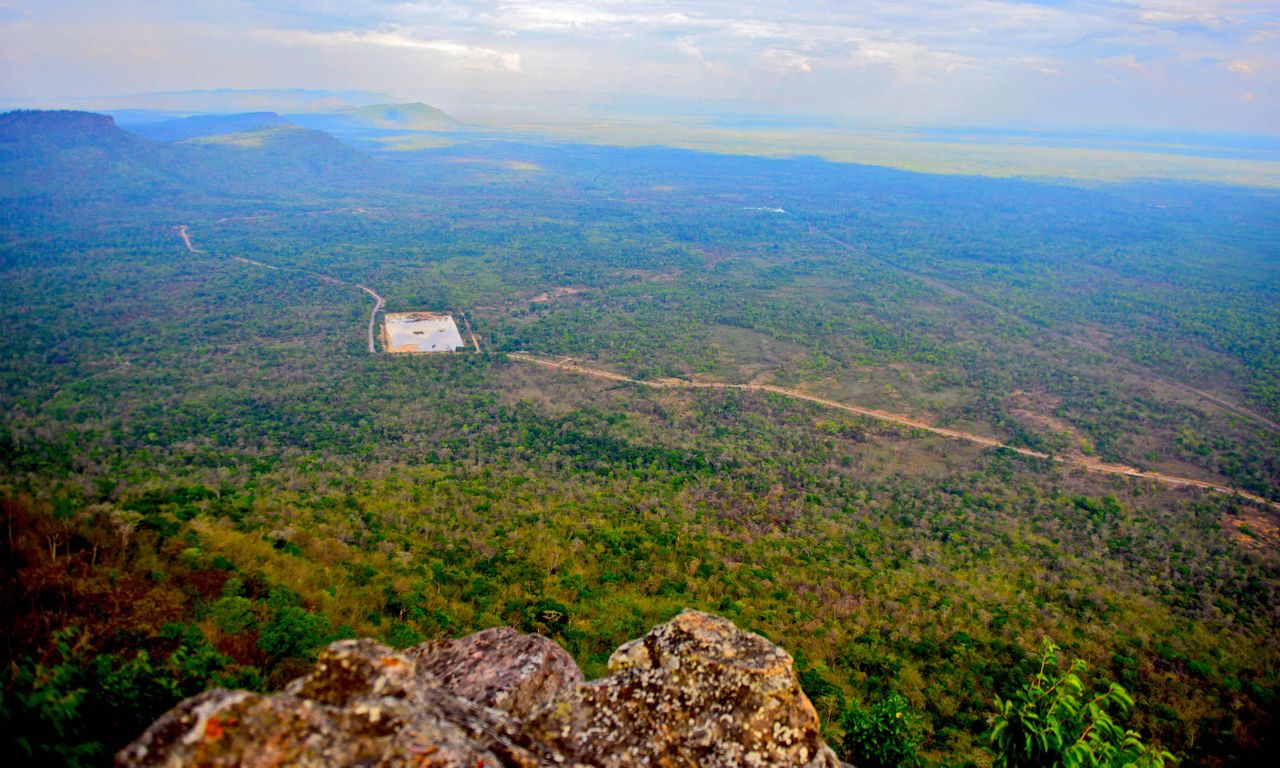
View over northern Cambodia (Mark Stratton)
Finding peace
The final approach to Preah Vihear temple followed the rounded massifs of the forested Dangrek Mountains along the Thai border. In the spirit of patriotic Khmer fervour, the temple was attracting mainly Cambodian sightseers, while its reopening has spawned many new hotels catering to the locals' theme-park tastes - my accommodation at Preah Vihear Boutique Resort came complete with life-sized white elephant statues bookending the entrance.
For those who do not fancy the sweaty, if exhilarating, mountain hike to the temple, 4WD or motordop (motorbike taxis) are on hand at the ticket office. We stopped en route near the Keo Sekhakirisvara monastery, whereupon small girls clutching bouquets of lotus flowers soon besieged the local visitors, predicting they would head into the monastery's temple to make an offering.
The building itself actually looked brand new. And indeed it was - I met the head monk, Sun Sang, as he was splashing red paint on the entrance way. This brave man had refused to budge throughout the years of armed fighting, and he'd had to watch as his monastery burned down courtesy of the Thai shelling.
"Some days I remained in the bunkers with the soldiers and could hear the bullets," he said, simulating a 'tik-tik-tik' noise to mimic the ricochets, then he showed me the bunker with its macabre ornaments of rusting mortar bombs hanging above its entrance.
Beyond the monastery lay a plateau where the ancient Preah Vihear complex stretched linearly for approximately akilometre. The views swept far into Thailand and Cambodia, and even towards Laos, demonstrating why the two warring factions so craved this strategically placed sacred mountaintop. The whole scene was as photogenic as anything I'd seen at Angkor.
An uneven stone staircase with a balustrade of lions marked the temple's main portal, and started just above the new No-Man's Land demarcated by razor wire. The Thai border guards were within shouting distance but the Cambodian soldiers seemed unfussed, preferring to concentrateon a game of volleyball.
"Angkorian temples usually run from east to west, but all other sides to this escarpment are steep cliffs, so the entrance is to the gentler slopes of the north," Bunthoeun explained as we ascended the staircase along the north-south axis, filling in the backstory.
The history of this complex can be traced all the way back to the 9th century, but successive Angkorian kings enriched it over the following 400 years. And while Preah Vihear was initially dedicated to the Hindu god Shiva, by the end of the 12th century it had switched to Buddhism along with the rest of the empire.
A paved causeway lined with stone lotus buds linked a series of five gopura (gateway towers) that became larger and more grandiose as we climbed. Set on stepped plinths, each structure supported eaves that reared up in the form of naga. Load-bearing capital blocks were propped up on square columns like cricket wickets and spiral colonettes decorated windows and doorways. Most magnifi cent were the triangular pediments above them, sculpted with scenes from the Hindu texts.
One temple displayed the creation myth of the churning of the oceans to create the sacred nectar of immortality, amrita. On the third gopura, an exquisite bas-relief showed Krishna lifting a mountain to protect holy cows from a storm while, elsewhere, Vishnu is seen slaying two demons represented by a lion and an elephant.
This was once a pilgrimage site for the great Angkorian kings, said Bunthoeun: "Archaeologists have found engraved Sanskritscript telling how Suryavarman II (1113-1150 AD) arrived with a procession of 150 elephants and monks carrying golden parasols."
Beyond the highest gopura, where two novice monks dispensed blessings amid a fug of sandalwood incense, we wandered over to the southern escarpment's edge. There, I found a small hermit's cave where legend says post-Angkorian general Ta Di meditated, considering what strategy to adopt as the Siamese defeated his Khmerarmy. In the end, he decided upon suicide, so he could enter the spirit world and return with a ghost army to defeat Siam.
As a late afternoon calm sank over the temple complex, the last of the local visitors departed and it felt liberating to have such a treasure to myself. These vast flatlands would appeal to any traveller after an authentic Khmer experience among unheralded ruins, friendly local communities and a land still bearing the marks of its recent past.
At Preah Vihear it was so quiet nearing sundown that I could hear the Thai border guards' radio broadcasting across the No Man's Land. If Ta Di was still alive, I thought, he might sigh to think the Siamese had not gone away. Yet today it is peace rather than bullets that reigns over this rediscovered jewel of northern Cambodia.
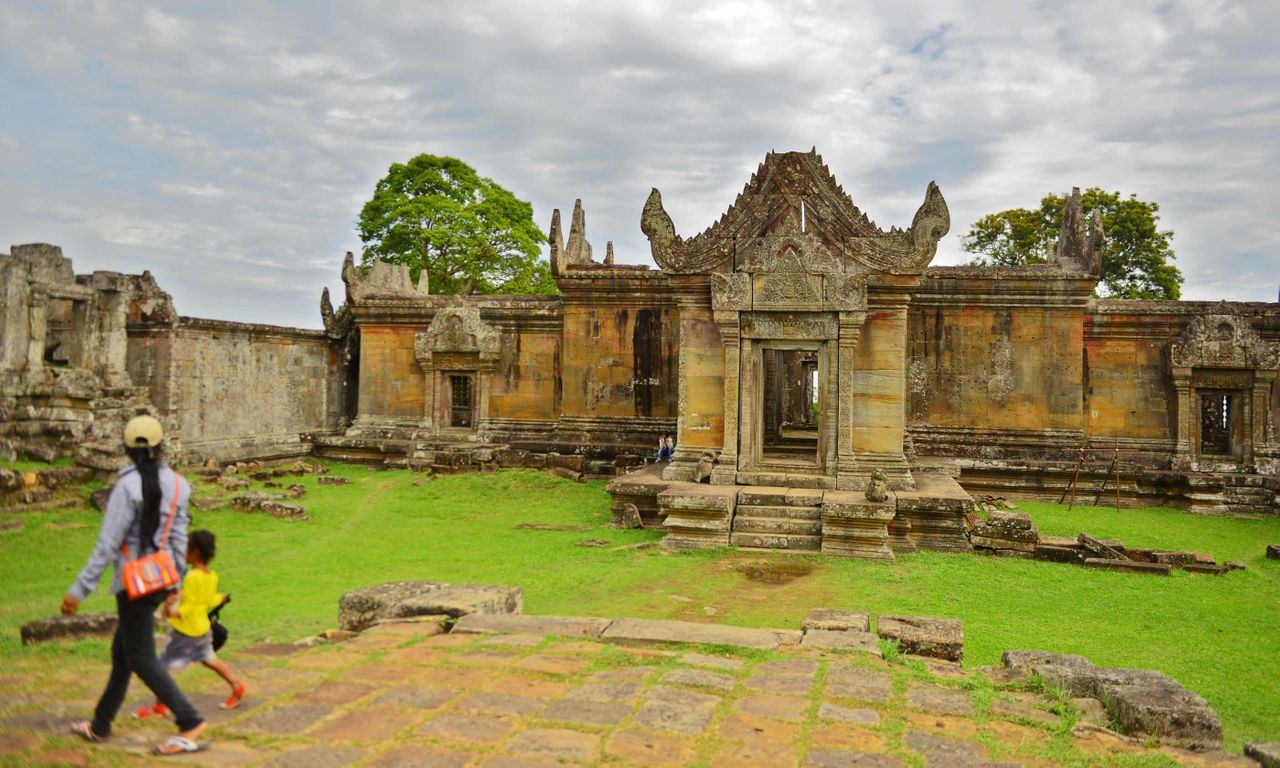
Preah Vihear temple (Mark Stratton)
The author travelled with Inside Asia (www.insideasiatours.com, 0117 244 3370), which offers a ten-night itinerary. This takes in Preah Vihear, Banteay Chhmar, a homestay, Sambor Prei Kuk and Angkor Wat, including all accommodation, transfers and guiding; international flights are not included.
Siem Reap's Jaya House River Park (jayahouseriverparksiemreap.com) is very new. Its selling point is its stylish decor and peaceful riverside location, away from Pub Street. B&B double rooms include complementary tuk-tuk to Angkor Wat and free mini-bar.
Banteay Chhmar Homestays (visitbanteaychhmar.org) offer an engaging and simple way to understand and get closer to local village life. Private rooms are cheap, with breakfast and local meals costing extra.
The Preah Vihear Boutique Hotel (preahvihearhotels.com) isn't exactly boutique but this medium- sized resort has large western-style rooms and a swimming pool, with doubles, including breakfast.
Sambor Village (Kampong Thom; samborvillage.asia) is a delightfully modern riverbank property located in a tropical garden.
Villa Lankga Hotel (Phnom Penh; villalangka.com) is a bit tucked away from Phnom Penh's lively waterfront but is an oasis of calm with big bright doubles.

No comments:
Post a Comment